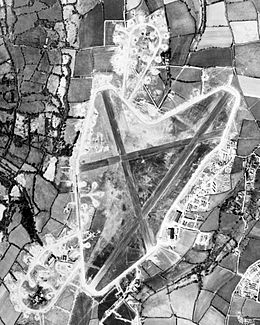Dunkeswell Aerodrome
| Dunkeswell Aerodrome | |
 | |
|---|---|
| Code | , ICAO: EGTU |
| County | Devon |
| Private | |
| Operator | Air Westward Co. Ltd. |
| Location | ST132075 50°51’38"N, 3°14’2"W |
| Runway(s) | 3,176 feet (Asphalt) 2,113 feet (Asphalt) |
| Website | www.dsft.co.uk |
Dunkeswell Aerodrome is an airfield in eastern Devon, lying some five miles north of the county's gateway town, Honiton, and 14 nautical miles north-east of Exeter. It is a busy civilian airfield with a mix of light aircraft, microlights and parachuting.
Nearby (1 nautical mile from the field) is North Hill, an airstrip run by the local gliding club.
Dunkeswell Aerodrome has a CAA Ordinary Licence (Number P674) that allows flights for the public transport of passengers or for flying instruction as authorised by the licensee (Air Westward Limited). The aerodrome is not licensed for night use.[1]
Dunkeswell Airfield Heritage Centre, is situated to one side of the large propellor memorial.
History
The airfield was opened in 1943, during the Second World War, as RAF Dunkeswell. The station was originally planned as a RAF Fighter Command, then a RAF Coastal Command airfield, but was transferred for use by American units.[2]
The station was first used by the American United States Army Air Forces Antisubmarine Command, 479th Antisubmarine Group, as a base of operations to fly antisubmarine missions over the Bay of Biscay using specialized B-24 Liberator bombers from August until November 1943.[3][4][5]
In November the United States Army Air Forces turned over the antisubmarine mission to the United States Navy and its Liberators were reassigned to Navy Patrol Bomber Squadron VPB-103, Fleet Air Wing 7, which continued aerial antisubmarine operations from the station, the AAF aircraft being redesignated under the USN/USMC system of the time as PB4Y-1 Liberators. This was the first United States Navy unit to train with the RAF, later followed by VB-105 and VB-110. The Naval antisubmarine squadrons moved to RAF Upottery in November 1944.[2][6][7]
With the departure of the Americans, the RAF used the airfield from August 1945 to April 1946 for ferrying aircraft to the Middle East by 16 Ferry Unit, RAF Transport Command. After September 1946 the station was put on care and maintenance status until the end of 1948, when it was sold by the Ministry of Defence.[2]
Outside links
| ("Wikimedia Commons" has material about RAF Dunkeswell) |
References
- ↑ Civil Aviation Authority Aerodrome Ordinary Licences Template:Webarchive
- ↑ 2.0 2.1 2.2 www.controltowers.co.uk Dunkeswell
- ↑ Maurer, Maurer (1983). Air Force Combat Units Of World War II. Maxwell AFB, Alabama: Office of Air Force History. ISBN 0-89201-092-4
- ↑ US Air Force Historical Research Agency microfilm 00199740 containing charts and documents describing operations of 479th Antisubmarine Group from UK stations
- ↑ Wakefield, Ken (1994). Operation Bolero: The Americans in Bristol and the West Country 1942-45. Crecy Books. pp. 61–62. ISBN 0-947554-51-3.
- ↑ United States Army Air Force Antisubmarine Command History
- ↑ www.controltowers.co.uk Upottery
